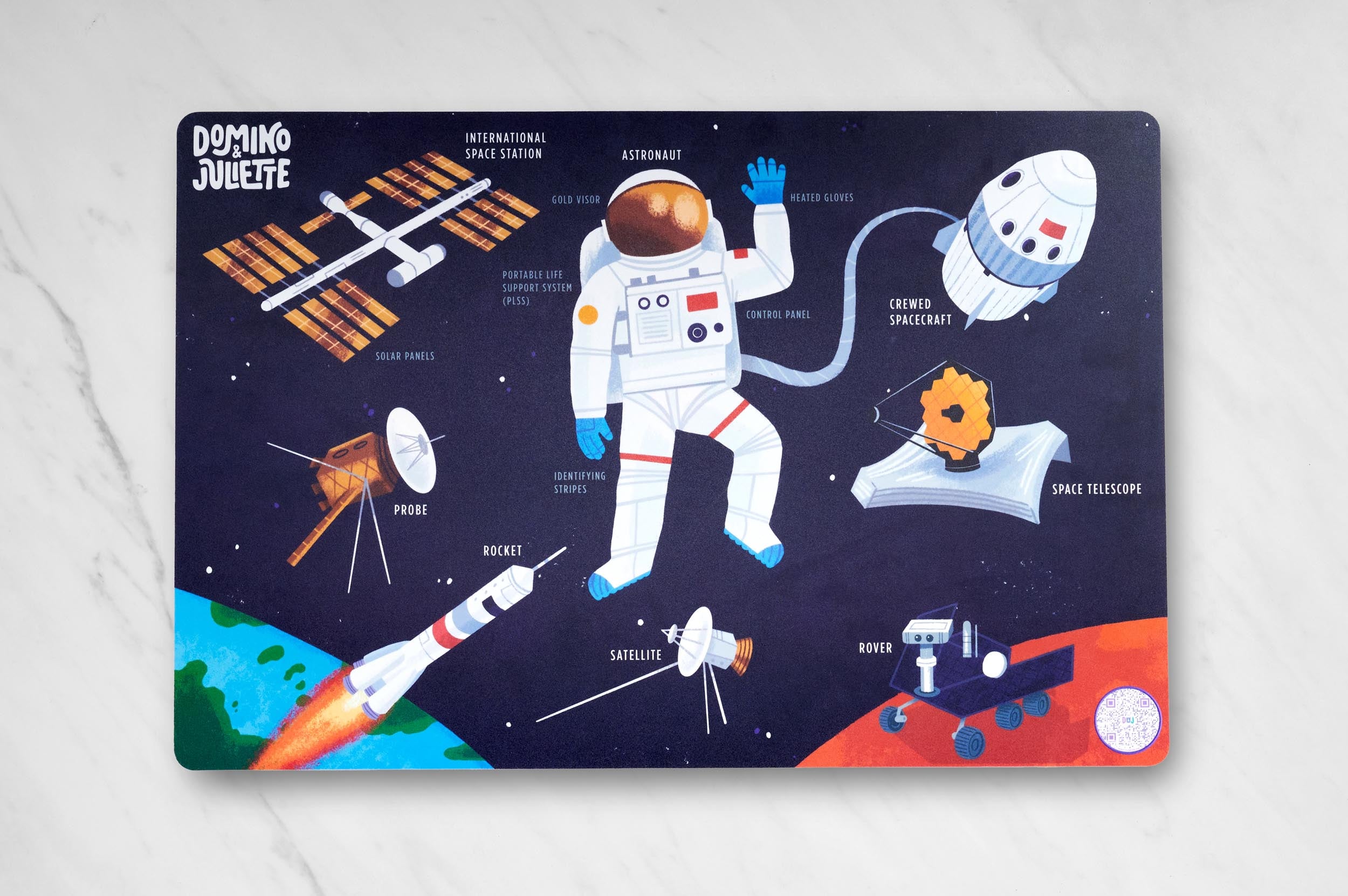
Welcome to the Bright Idea Zone!One toy, many ways to play
Unearth intriguing facts and information that will delight learners of all ages and enhance the placemat experience! Do you want to share the fun with your children off the screen? Simply click to download the printer-friendly children’s version of this page or access your bonus printable coloring pages. Get ready to embark on an educational adventure!

Get ready for an exciting adventure through the vastness of space! Space exploration is when people build special machines called spacecraft to zoom across the universe and learn more about our cosmic home. It's like being an explorer in the greatest treasure hunt of all time!
Many, many years ago, humans looked up at the stars and wondered what was out there. It wasn’t too long ago in the late 1950s the United States and other countries began sending rockets and satellites into space to explore and learn new things. NASA, which stands for the National Aeronautics and Space Administration, is a big group of really smart people in the United States who work together to study space and make these amazing adventures happen.
One of the most exciting moments in space exploration was when NASA sent astronauts to the Moon! In 1969, astronauts named Neil Armstrong and Buzz Aldrin were the first people to step on the Moon's surface. They left footprints and even planted a flag!
Nowadays, we have even more fantastic ways to explore space. There's a company called SpaceX, which is building incredible rockets and spacecraft to help us visit other planets like Mars someday. Imagine one day living on another planet or walking on the red, sandy surface of Mars!
So, buckle up, and let's embark on a thrilling journey through the wonders of space exploration! Who knows what amazing discoveries are waiting for us out there among the stars?

An astronaut is a super cool explorer who travels into space to learn about the stars, planets, and everything else in the universe. They train really hard to become experts at flying in special ships called spacecraft and working in places where there's no air to breathe and where tiny space rocks are flying all around, like the Moon or Mars!
In order to do their jobs safely they must wear a space suit.
Space suits are like superhero costumes in that they’re super strong and packed with cool gadgets, like a built-in radio to talk to their friends on Earth and special gold visors to protect their eyes from the bright Sun. These visors are able to reflect infrared light while letting in visible light, protecting the astronauts' eyes from unfiltered sunlight. Astronaut helmets also have a ventilation system that provides them with oxygen so they can breathe.
When exploring space you want to be able to use your hands and fingers, right? How else can you touch and pick up objects? Space suit gloves protect astronauts from the space environment and are made so spacewalkers can move their fingers as easily as possible. The fingers are the part of the body that gets coldest in space, similar to your fingers on a cold day here on Earth, and the gloves on spacesuits are equipped with heaters to keep fingers warm while still allowing dexterity, or movement ability, to use tools.
On the flipside, astronauts can get very warm while working hard to walk in their suits for multiple hours. To avoid heat build-up, they wear a cooling garment under their suits that is lined with water tubes to keep them cool throughout the spacewalk. There’s no skipping out on a jacket or hat in space! Without the space suit, outer space exploration wouldn’t be possible.
But what do they bring with them? Is there special equipment?
You bet! The Portable Life Support System (PLSS) is a high-tech backpack with everything astronauts need while they explore: Electricity, a fan, carbon dioxide removal system, water tank for the cooling garment, and a 2-way radio. On the Hard Upper Torso of the suit (the HUT), there is a control panel which operates the backpack.
With all of this gear on (including the reflective Gold Visor), it can be hard for Astronauts to tell each other apart during spacewalks. To clear up any confusion, there are red or white identifying stripes on the strip of their lower torso to allow them to identify each other.
When astronauts wear their space suits, they're ready for any adventure, whether it's floating in a spaceship, walking on the Moon, or exploring new planets!
Now that we have introduced the star characters (no pun intended) of this cosmic setting, let’s continue to set the stage for our outer space adventures!

A satellite is an object that orbits around another object in space. Just like the moon orbits around the Earth, satellites can orbit around planets including Earth. Satellites can be natural, like the moon, or they can be artificial, which means that they were created by humans. Artificial satellites are sent into space on rockets and are designed to observe the Earth, communicate with people on the ground, or even help us explore other planets!
There are many types of artificial satellites, but some of the most common ones include communication satellites, weather satellites, navigation satellites, and scientific satellites.
Communication satellites are used to transmit phone calls, TV signals, and other forms of communication around the world. Without them, you might not be able to call Grandpa across the country or watch the Macy’s Thanksgiving Parade! Weather satellites help us track storms, hurricanes, and other weather patterns so that we can predict what the weather will be like on your upcoming soccer game or planned family vacation. Navigation satellites, like GPS, help us find our way around the Earth by using signals from satellites to pinpoint our location. Finally, scientific satellites are used by scientists to study things like the Earth's atmosphere, the oceans, and the universe beyond our planet. Goodness! Satellites sure are important! But we’re missing the most famous one:
The International Space Station, or ISS for short, is like a giant clubhouse floating in space! It's a huge spacecraft where astronauts from different countries live and work together while they zoom around Earth. Anyone changing what they might want to be when they grow up? The ISS is a place where people from all around the world come together to learn about space and connect over exciting experiments.
The ISS is made of many different parts called modules, or various sections of rooms in one big space house. The astronauts on the ISS have a place to sleep, eat, exercise, and peek out the window at the beautiful Earth below. They also have a laboratory where they do science experiments that help us learn more about how things work in space.
The International Space Station has been operating high above Earth since 1998, and it's been home to hundreds of astronauts from countries like the United States, Russia, Japan, Canada, and Europe. It travels really fast, too! The ISS zooms around Earth at a speed of 17,500 miles (28,000 kilometers) per hour, which means it orbits, or goes around, our planet once every 90 minutes. That's 16 sunrises and sunsets every day!
So now we know there’s a neighborhood floating in the cosmos, but what about transportation? How do we travel from Earth to the ISS and elsewhere? Surely there must be a Space Tesla or something? Well, not quite, but there are crewed spacecraft.
A crewed spacecraft is like a space taxi that carries astronauts into space to explore and learn new things. It's a special kind of spaceship designed just for people, with everything they need to live and work while they're on their exciting journey through the stars. Perhaps it’s like traveling in an RV across the country, only this time the country is outer space! When a crewed spacecraft is launched into space it's carried by a rocket. The rocket provides the necessary thrust to lift the spacecraft off the ground and into orbit around the Earth or to travel to other destinations in the solar system.
Crewed spacecraft have played a significant role in space exploration. They've taken astronauts to exciting places like the Moon and helped them reach the International Space Station, that giant clubhouse we talked about earlier. These spacecraft are built to keep astronauts safe and comfortable while traversing the cosmos.
Inside a crewed spacecraft there is a cockpit which has seats for the astronauts, controls to fly the spaceship, and all kinds of cool equipment for the astronauts to use during their mission. There is also a Life Support System which provides astronauts with air to breath and keeps the temperature just right. There is a kitchen and dining area and even a place to sleep and exercise!
Sometimes crewed spacecraft need to connect to other spacecraft or space stations, like the International Space Station. They have a special docking system that lets them attach to other space vehicles so astronauts can move between them safely.
And what goes up must come down! When a spacecraft returns to Earth, it can get really hot from the friction with Earth's atmosphere. The spacecraft is equipped with a heat shield that protects the spacecraft and the astronauts inside from the extreme heat, so they can land safely back home.
These incredible spacecraft have taken humans on some out-of-this-world adventures. They've helped us learn more about the universe, discover new things about our own planet, and have even worked together with other countries to make friends in space. They’re a big part of what makes exploring space so much fun!

But did you know, sometimes space is explored via spacecraft without a single human aboard?
Probes are unmanned spacecraft that don't carry astronauts but are packed with scientific instruments and cameras to take pictures and collect data. Since they don't have people on board, probes can go on really long missions sometimes lasting many years, allowing for them to explore the outer reaches of our solar system. They can be sent to orbit or to land on planets and moons to gather data.
Another space contraption that is sent into space to explore is a Rover. A rover is also designed to operate for long periods of time and to move around on the surface of a planet or a moon typically equipped with various scientific instruments for exploration and study.
So probes and rovers are both used for exploration. The key difference is that probes typically do not move around on the surface of a planet or moon while rovers are specifically designed to do so. Probes can travel much faster and farther through space whereas rovers are better suited for exploring a specific area in detail.
Once the information has been gathered by the probe or rover it gets sent back to Earth, where scientists study the data to learn new things and make exciting discoveries. One of the most famous rovers is the Mars rover. There have actually been several Mars rovers over the years, each one more advanced than the last. The most recent Mars rover is called Perseverance, and it landed on Mars in February 2021. Perseverance is very cool because it has a lot of high-tech features. For example, it has a special helicopter drone that can fly around and explore areas that the rover can't reach on its own. Perseverance is also looking for signs of ancient life on Mars, which could help us understand whether there was ever life on other planets in our solar system.
Probes and satellites can carry telescopes and other instruments for observing the universe. A telescope is a device used to observe and study the universe, by collecting and analyzing electromagnetic radiation (such as visible light, X-rays, and radio waves) that is emitted by celestial objects like stars, planets, and galaxies. Telescopes come in many different shapes and sizes, and they can be used both on the ground and in space. You may even have one at home!
Space telescopes are telescopes that are specifically designed to be launched into space and to observe the universe beyond the interference of the Earth's atmosphere. Unlike ground-based telescopes, which can be affected by atmospheric turbulence and light pollution, space telescopes can capture clearer and more detailed images of the universe.
NASA’s largest and most powerful space science telescope ever constructed is the James Webb Space Telescope which launched on December 25th, 2021. As the largest optical telescope in space, it is equipped with high-resolution and high-sensitivity instruments, allowing it to view objects too old, distant, or faint for the Hubble Space Telescope to have seen. Take a moment and have a parent look up images captured by the Webb Telescope and be ready for some spectacular space art!
Thanks to these amazing robot explorers and technological instruments, we're able to explore the universe from the comfort of our own planet and keep learning more about the incredible mysteries of space!
So what would you rather do? Are you more hands-on and wanting to explore space by actually being in space? Or do you prefer the comforts of home and studying it from afar? There’s no wrong answer, only preferences and it can be fun to talk about. Either way, we’re sure you’ll have a blast exploring the mysteries of the universe.